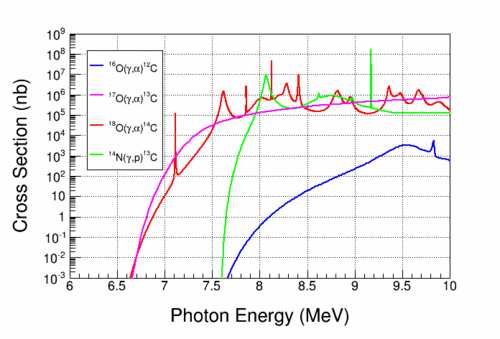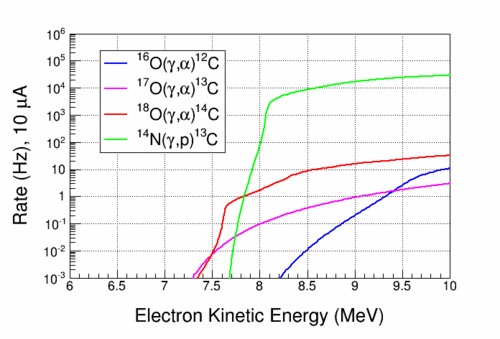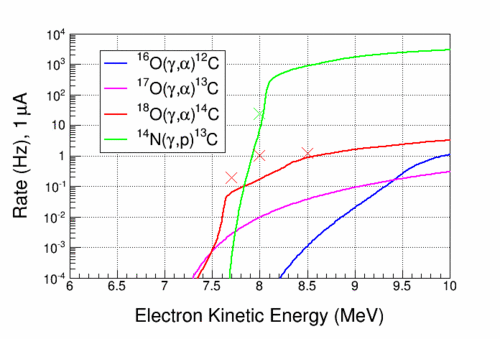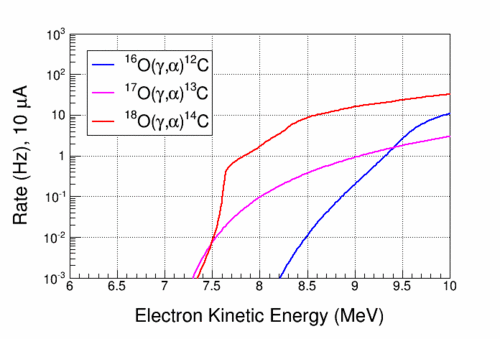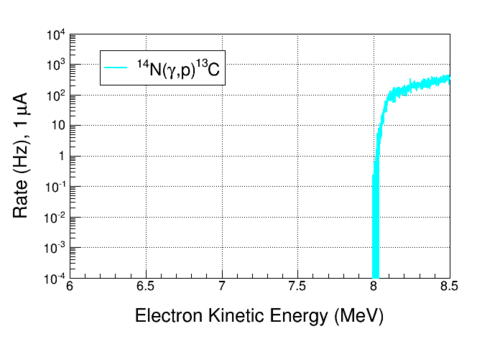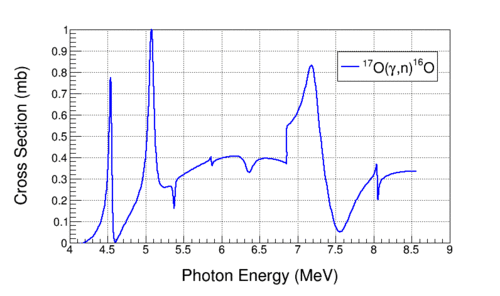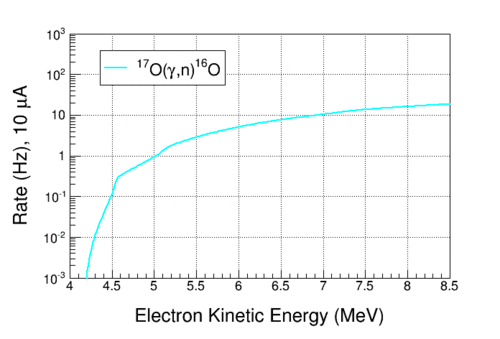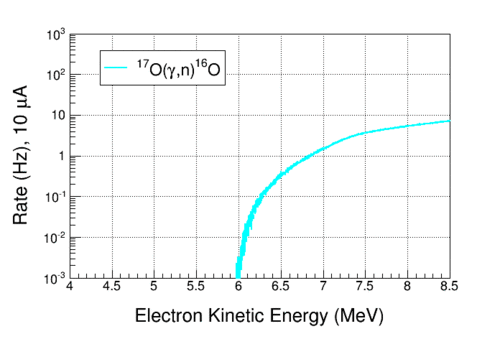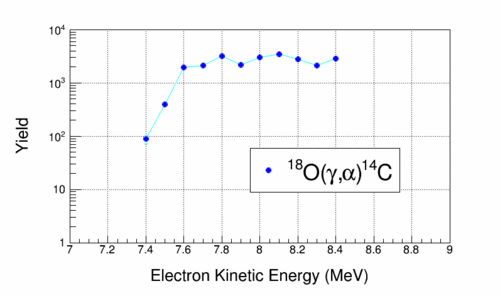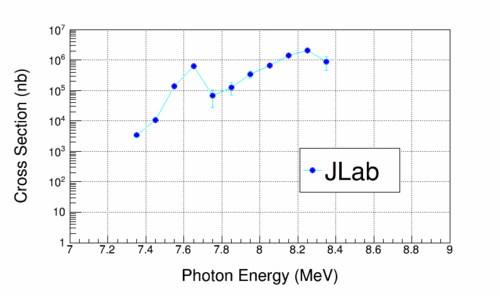Bubble Chamber Beam Test May 2018
Jump to navigation
Jump to search
The printable version is no longer supported and may have rendering errors. Please update your browser bookmarks and please use the default browser print function instead.
Bubble Chamber Turn On
- Fill with natural N2O – test bubble chamber systems operation
- With beam on bubble chamber radiator:
- How does CCD camera perform under beam-on conditions?
- Count rates on bubble chamber. Do we get single or multiple bubbles from Bremsstrahlung beam exposure?
- Measure gamma ray beam spatial profile as reflected by bubble distribution. Is collimator effective in defining the gamma-ray beam?
- Test the bubble chamber laser shutter (gumby shutter)
- Background measurements:
- Measure beam off environmental background in chamber-injector area
- Measure beam on background by looking outside fiducial volume
- Measure background with beam to Faraday Cup in CEBAF beamline (about two meters from chamber)
- Measure neutron events in chamber. Neutron radiation detectors in injector region will indicate if any neutrons are generated (especially at beam kinetic energies higher than 8.5 MeV).
Bubble Chamber Beam Test
- Chamber is filled with natural N2O
- Cross sections:
The cross sections are shown in the following figure:
- Expected rates:
The expected rates are calculated with 3 cm cell thickness and Bremsstrahlung beam from copper radiator.
- The expected rates are shown in the following figure:
- The expected rates with the latest data are shown in the following figure:
- The expected rates from oxygen isotopes are shown in the following figure:
- The expected rate from 14N(γ,p)13C with ThrCut = 50 keV is shown in the following figure:
- Root macros to calculate 14N(γ,p)13C with different threshold cuts (change .txt to .tar): media:Rate_14Ngp_ThrCut.txt
- 17O(γ,n)16O cross section:
- The expected rate from 17O(γ,n)16O is shown in the following figure:
- The expected rate from 17O(γ,n)16O with ThrCut = 130 keV is shown in the following figure:
- Root macros to calculate 17O(γ,n)16O with different threshold cuts (change .txt to .tar): media:Rate_17Ogn_ThrCut.txt
Run Plan:
- Check if Bubble Chamber is working properly:
- Start with K.E. of 7.7 MeV
- Determine the initial operational pressure and temperature
- Measure bubble rate. The expected rate is 1 bubble per sec at 10 µA
- Measure rate vs beam current (0.01, 0.1 and 1.0 µA)
- Measure the number of bubbles for 30 minutes per beam current
- Suppression of 14N(γ,p)13C events:
- Start with beam at K.E. 7.0 MeV
- Increase beam K.E. by 0.2 MeV steps all the way to 8.6 MeV
- Adjust beam current to maintain a bubble rate of few per minute
- Measure the number of bubbles for 30 minutes per energy
- Reproduce the overall rate shown above
- At K.E. of 8.6 MeV, increase the chamber threshold by increasing the pressure. Suppress the 14N(γ,p)13C events.
- Once 14N(γ,p)13C is suppressed, the rate should drop by three orders of magnitude
- Measuring rates from 18O(γ,α)14C:
- Now the chamber is at the new pressure
- Start with beam at K.E. 7.2 MeV
- Increase beam K.E. by 0.2 MeV steps all the way to 9.2 MeV
- Adjust beam current to maintain a bubble rate of few per minute
- Measure the number of bubbles for 30 minutes per energy
- Reproduce the overall rate from oxygen isotopes shown above
- Note the change in slope of rates vs. beam K.E. and the sharp kink around 7.6 MeV
- Measuring 18O(γ,α)14C cross section:
- Start with beam at K.E. 7.4 MeV
- Increase beam K.E. by 0.1 MeV steps all the way to 8.4 MeV
- Adjust beam current to maintain a bubble rate of few per minute
- Perform Penfold-Leiss unfolding
| Beam Kinetic Energy (MeV) | Beam Current (µA) | Time (hour) |
| 7.4 | 10 | 10 |
| 7.5 | 10 | 10 |
| 7.6 | 10 | 5 |
| 7.7 | 2 | 5 |
| 7.8 | 2 | 5 |
| 7.9 | 1 | 5 |
| 8.0 | 1 | 5 |
| 8.1 | 0.8 | 5 |
| 8.2 | 0.4 | 5 |
| 8.3 | 0.2 | 5 |
| 8.4 | 0.2 | 5 |
The expected yield (counts) is shown in the following figure:
The Penfold-Leiss unfolded cross section is shown in the following figure:
- Root macro files used to generate the figures above (change .txt to .tar): media:BubbleTest_Sept.txt
Analysis Files
- Presentations
- MCC 8 am presentation: media:FirstTests.pdf media:FirstTests.pptx
- Filling Chamber with nitrous oxide: Movie [1]
- MCC 8 am movie first event: media:FirstBubble.gif
- September 12, 2015 Morning work: media:sept12morning.png
- September 12, 2015 Morning work: media:corrected.png
- Events in fiducial volume: media:comp.png
- Beam Current:
The following command dumps the archived current readback (-A) from Keithley Picoammeter K6485 to a file:
mySampler -b "2015-09-10 18:00:00" -s 1s -n 14400 IFY5D04K6485dataRead > BubbleCur_Sept10.txt
- Data file of beam current on Bubble Chamber Faraday Cup or Radiator/Dump (September 10, 18:00 - 22:00): media:BubbleCur_Sept10.txt
- Data file of beam current on Bubble Chamber Radiator/Dump (September 11, 17:00 - 24:00): media:BubbleCur_Sept11.txt
- Data file of beam current on Bubble Chamber Radiator/Dump (September 12, 9:00 - 24:00): media:BubbleCur_Sept12.txt
- Data file of beam current on Bubble Chamber Radiator/Dump (September 13, 9:00 - 19:00): media:BubbleCur_Sept13.txt
- Data file of beam current on Bubble Chamber Radiator/Dump (September 14, 13:00 - 24:00): media:BubbleCur_Sept14.txt
The following command dumps the archived current readback from BCM0L02 Gigatronics (µA) to a file:
mySampler -b "2015-09-15 15:00:00" -s 1s -n 18000 IBC0L02Current > BubbleCur_Sept15.txt
- Data file of beam current on Bubble Chamber Radiator/Dump (September 15, 15:00 - 20:00): media:BubbleCur_Sept15.txt
- Data file of beam current on Bubble Chamber Radiator/Dump (September 16, 15:00 - 22:00): media:BubbleCur_Sept16.txt
- Data file of beam current on Bubble Chamber Radiator/Dump (September 17, 15:00 - 19:00): media:BubbleCur_Sept17.txt
- Beam Energy:
The following command dumps the archived data relevant to measuring beam energy to a file:
mySampler -b "2015-09-10 18:00:00" -s 100s -n 6912 R027GSET R027GMES R027PSET R027PMES R028GSET R028GMES R028PSET R028PMES MDL0L02.BDL MDL0L02M > BubbleEne_Sept2015.txt
- Data file for beam energy measurements (September 10, 18:00 - September 18, 18:00): media:BubbleEne_Sept2015.txt
Logbook: List of Runs
A copy of the paper logbook: media:Bubble_Chamber_Sept_2015_Runs_List.pdf
Things To Do Next
No Beam Checklist
- Survey and align 5D line
Beam Checklist
- Calibrate 0L02 BCM
- Quad-center 0L02, 0L02A, 5D00, 5D01 and set BPM SOFs accordingly
- Measure beam position directly after radiator
